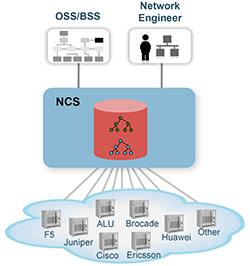Network Abstraction: The Key to Agility
Tail-f's Network Configuration Server (NCS) is a software solution for provisioning multi-vendor services and configuring network devices and fully meets the requirements for a network abstraction layer.
With NCS, users and developers can use network-wide APIs and user interfaces to configure devices and provision services with a minimum of effort. The network API provides transaction-safe configuration changes to the network and the transactions include the actual devices in the network. This takes away tedious low-level work with various protocols or different CLIs. For example, the unified NCS CLI lets administrators easily configure and inspect configuration changes over many devices from different vendors.

NCS provides a unique way to map service configurations to corresponding device changes. This is normally a development project which itself blocks the introduction of new service types. With the NCS FastMap technology, the mapping is condensed to one simple page of definitions. Not only does this speed up the introduction of new services, it also guarantees the accuracy of the service configuration and corresponding device configuration.
A blocking factor for deploying network automation is the cost and time to integrate the device interfaces. NCS provides a powerful interface technology that makes it possible to integrate new CLI-based device types in days and NETCONF-based devices like Juniper instantly. Traditional adapters block network upgrades since the adapters need to be upgraded first. The NCS model-driven device integration effectively removes this roadblock.When new devices support new features there is a need for a new or refined service definition that usually requires time-consuming software programming. NCS is model-driven and automatically renders user interfaces so devices can be upgraded and new services can be defined without disruptive delays. In addition to smoothly accommodating changes in services and device portfolios, NCS scales from small networks to extremely large networks without any administrative tasks.
Summary
New services are complex to provision and require frequent and granular configuration changes to network equipment. Existing approaches to service provisioning and device configuration are dependent on manual processes and ad hoc scripting tools. These approaches are error-prone and hamper services agility. Adding a network abstraction layer to existing OSS systems enables CSPs to program their underlying network to quickly support new services and change existing ones. Configuration changes are made automatically with built-in transaction management to prevent errors. This approach reduces time-to-market, speeds service activation, and allows networks to scale cost effectively.
-------------------------
About Tail-f Systems
Tail-f Systems is the leading provider of configuration management and network automation software. Service Providers use Tail-f’s technology to quickly integrate powerful network abstraction layers to their OSS systems and benefit by bringing network services to market faster and more reliably. Seven of the ten largest global networking equipment providers are Tail-f Systems’ customers.Network Equipment Providers use Tail-f’s software to build on-device management systems and EMS/NMS platforms in less time and with differentiated capabilities. Tail-f Systems is one of Stratecasts’ 2012 Global OSS/BSS 10 to Watch Companies and a Red Herring Top 100 company. See www.tail-f.com.



















